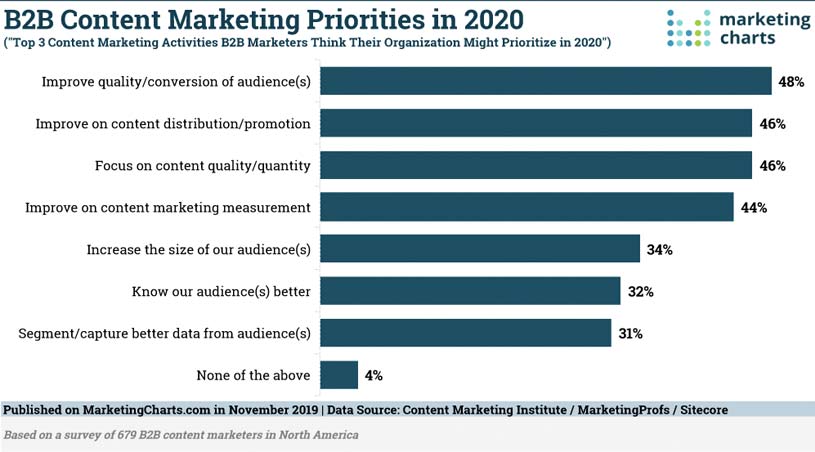What is B2B Content Syndication and Why is it important?

Table of Contents
B2B content syndication is a key lead generation avenue for many large enterprises. It allows you to get your resource-intensive content in front of a larger audience than you would typically get when just hosting it on your website.
The distribution of content will remain a top priority for B2B marketers. In fact, 46% of B2B marketers will focus in 2020 on improving their content distribution channel, which includes content syndication.

You might wonder about the SEO implications when hosting content on third-party websites. Will duplicate content not result in receiving penalties from Google and other search engines?
We will dive into those details shortly, but first, let’s focus on the basics of B2B content syndication.
What is B2B Content Syndication?
The meaning of B2B content syndication is when digital content such as whitepapers, blogs, and videos are re-published to a third-party website. The core aim of content syndication is to generate new leads from prospective customer accounts.
B2B marketers generally make agreements with content syndication vendors about the number of leads they want to generate from a content syndication campaign.
With content syndication campaigns, you can expect to pay around $80-$100 per director level and above lead. Generally, you can include qualifying questions. As you may expect, the more qualifying questions you include, the higher the Cost per Lead (CPL).
It depends on your marketing strategy if you should include qualifying questions. It’s definitely something I recommend doing. The reason being, that your sales organization is busy and they are expensive. The last thing you want is that sales are wasting time on unqualified and cold leads.
Even with qualifying questions, leads generated from content syndications campaign will almost always be cold leads. You need to have a nurture campaign that warms up the leads before handing them over to sales.
If you don’t have a nurture campaign, your campaign is guaranteed to fail and will result in an unfavorable return on investment.
What are the benefits of B2B Content Syndication?
As mentioned in the opening paragraph of this article, content syndication plays a tremendous factor in generating B2B leads.
Many successful B2B organizations have a strong focus on account-based marketing. When negotiating with content syndication vendors, you can supply them with a named-account list (or target-account list). Consequently, they will only generate leads from accounts in the list you supplied.
If sales have a focus on named accounts, it doesn’t make sense if marketing is generating leads outside of that named-account list. 42% of B2B marketers will be exploring account-based marketing tactics in 2020. Content Syndication and account-based marketing go hand in hand.

Another benefit of content syndication is that you will get additional visibility on your content that wouldn’t be possible by solely hosting it on your website.
By selecting the right vendors, you can position yourself or a company as a thought leader. You can re-publish blogs to third-party vendors and gain maximum exposure. An example of syndicating blog content is by republishing your content to Medium. Effectively, this allows you to drive massive traffic to your website and eventually be positioned as a thought leader. To extend the period in which piece of content is generating value, update your content at the ideal time.
This strongly correlates to the next benefit which is driving high-quality links to your website. Link building remains pivotal in getting search engines to trust your website; especially if you’re working for a start-up. Republishing content will almost always result in a high-authority backlink; key for growth hacking your business.
The SEO implications of content syndication
It’s common knowledge that duplicate content across the web will have a negative impact on a site and its SEO. The results can be reduced rankings and even being removed from the Google index. Naturally, this is something to avoid at all costs.
When syndicating blog content to third-party websites, you need to ensure that the third-party website declares that the content on your website is the original source. This is done by adding a canonical tag.
To illustrate, I often syndicate content to Medium. My post about “How to get more ROI out of B2B Events” has been republished on Medium.

By looking at the source code of republished article on Medium, you can see that the page has a canonical tag.

It's a lot of code. Use the search function and type "canonical". The code that you are looking for is similar to the code displayed below.
<link data-rh="true" rel="canonical" href="https://www.markletic.com/blog/how-to-get-more-roi-out-of-b2b-events/"/>This canonical tag tells search engines that my article is the original source of the content.
Note: it can happen that even with a correctly implemented canonical tag, the third-party website will still be considered as the original source. This is something to avoid at all costs.
The reason why this happens has to do with domain authority. If two websites publish content at the same time, Google and search engines will index the article first with the highest domain authority and proper link structure.
To illustrate, let’s say your domain authority is 50. The content syndication vendor has a domain authority of 80. Google is more likely to pick up the article on the website where the domain authority is 80.
I strongly urge you to check your domain authority before engaging in content syndication campaigns. You can check your domain authority score through Semrush.
Does this mean that if you have a low domain authority that you can not engage in content syndication campaigns?
Fortunately, the answer is you can!
The solution is to first publish content on your website, submit the page to Google Search Console and wait for the page to be indexed. Once, indexed you can safely use that content in syndication campaigns.
Content Syndicate B2B whitepapers and case studies
Blog content is not and should not be the only content that you are using in B2B content syndication campaigns.
The sky is the limit, but generally speaking case studies, whitepapers, datasheets, webinars, and videos work well.
This content is usually gated; meaning behind a form. In order to avoid SEO penalties for such content, make sure that the accompanying descriptions or summaries of the content pieces are not the same as on your website. Also, consider changing the title. If possible, ask that the content syndication vendor will implement a canonical tag to the original source.
The importance of an integrated marketing campaign
If you think that leads from a content syndication campaign are warm enough to hand over to sales then you need to wake up. The leads are often cold leads, even with qualification questions implemented.
Your content syndication strategy should be closely integrated with your overall demand generation strategy.
Below a chart that shows that B2B marketers will focus on various strategies in 2020 including personalization, account-based marketing, conversational marketing, and video marketing.

These various buckets of strategies should be integrated with each other in order to realize the maximum business impact. The same goes for content syndication campaigns.
Leads generated should be warmed up through email nurture campaigns. When they visit your website, they should receive relevant messages from chatbots. They’ve now been on your website so you can place a cookie.
Great! Now you can implement remarketing to this person and show ads on LinkedIn. On LinkedIn, you can show him a relevant video. If the lead is showing interest and is from a target account, you can implement programmatic advertising to also warm up his or her colleagues.
With growth marketing, you need to pull out all stops. One interaction will never be enough. Align your content syndication strategy with your demand generation strategy. You’ll find that the conversion will be higher and cost per average MQL will reduce.
B2B content syndication vendors
There will be B2B content syndication vendors in every market; both global and local organizations.
Below are some organizations that I’ve worked together with and was able to move the needle. Note: I’m in no way affiliated to any of them.
This will help you to get started but always chat with an account manager and describe your target audience and content syndication expectations. In doubt, move on to another vendor.
Conclusion
Content Syndication is a key demand generation strategy for many B2B organizations. It will give your content and company extra exposure that it wouldn’t normally get.
It works well for organizations that focus on account-based marketing as you can give the content syndication vendor a list of your target accounts.
An easy way to get started is by article syndication to Medium. As Medium will implement a canonical tag, this will not result in any SEO penalties.
Leads generated through content syndication campaigns are almost always cold. An integrated marketing campaign that warms up the leads is a must. At least, if you don’t want to waste your marketing budget!
What’s the best content syndication vendor that you’ve worked with?

Share this article



